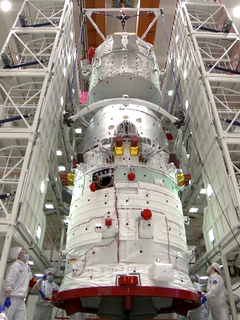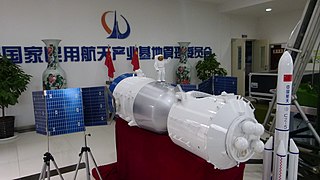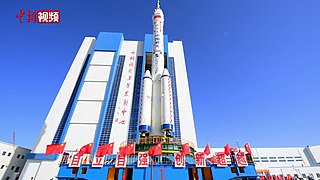
Shenzhou is a spacecraft developed and operated by China to support its crewed spaceflight program, China Manned Space Program. Its design resembles the Russian Soyuz spacecraft, but it is larger in size. The first launch was on 19 November 1999 and the first crewed launch was on 15 October 2003. In March 2005, an asteroid was named 8256 Shenzhou in honour of the spacecraft.

Shenzhou 5 was the first human spaceflight mission of the Chinese space program, launched on 15 October 2003. The Shenzhou spacecraft was launched on a Long March 2F launch vehicle. There had been four previous flights of uncrewed Shenzhou missions since 1999. China became the third country in the world to have independent human spaceflight capability after the Soviet Union and the United States.

The Long March 2F, also known as the CZ-2F, LM-2F and Shenjian, is a Chinese orbital carrier rocket, part of the Long March 2 rocket family. Designed to launch crewed Shenzhou spacecraft, the Long March 2F is a human-rated two-stage version of the Long March 2E rocket, which in turn was based on the Long March 2C launch vehicle. It is launched from complex SLS at the Jiuquan Satellite Launch Center. The Long March 2F made its maiden flight on 19 November 1999, with the Shenzhou 1 spacecraft. After the flight of Shenzhou 3, CPC General Secretary and President Jiang Zemin named the rocket "Shenjian" meaning "Divine Arrow".

The space program of the People's Republic of China is directed by the China National Space Administration (CNSA). China's space program has overseen the development and launch of ballistic missiles, thousands of artificial satellites, manned spaceflight, an indigenous space station, and has stated plans to explore the Moon, Mars, and the broader Solar System.

Shenzhou 6 was the second human spaceflight of the Chinese space program, launched on October 12, 2005 on a Long March 2F rocket from the Jiuquan Satellite Launch Center. The Shenzhou spacecraft carried a crew of Fèi Jùnlóng (费俊龙) and Niè Hǎishèng (聂海胜) for five days in low Earth orbit. It launched three days before the second anniversary of China's first human spaceflight, Shenzhou 5.

Geir Jenssen is a Norwegian electronic musician and composer who records as Biosphere. A resident of Tromsø within the Arctic Circle, Jenssen is well known for ambient and ambient house pieces, often inspired by Arctic or mountain settings, and his use of loops and peculiar samples from science fiction and natural sources. His 1997 album Substrata was voted by the users of the Hyperreal.org website in 2001 as the best all-time classic ambient album. He has also composed several film scores.
Shenzhou 2 launched on January 9, 2001, was the second unmanned launch of the Shenzhou spacecraft. Inside the reentry capsule were a monkey, a dog and a rabbit in a test of the spaceship's life support systems. The reentry module separated from the rest of the spacecraft after just over seven days in orbit, with the orbital module staying in orbit for another 220 days.
Shenzhou 4 – launched on December 29, 2002 – was the fourth uncrewed launch of the Chinese Shenzhou spacecraft. Two dummy astronauts were used to test the life support systems.

Shenzhou 7 was the third human spaceflight mission of the Chinese space program. The mission, which included the first Chinese extra-vehicular activity (EVA) carried out by crew members Zhai Zhigang and Liu Boming, marked the commencement of the second phase of the Chinese government's Project 921.

Tiangong, officially the Tiangong space station, is a space station constructed by China and operated by China Manned Space Agency (CMSA) in low Earth orbit between 340 and 450 km above the surface. Being China's first long-term space station and the core of the "Third Step" of the China Manned Space Program, it has a mass between 90 and 100 t, roughly one-fifth the mass of the International Space Station and about the size of the decommissioned Russian Mir space station.

Shin Megami Tensei If... is a Japanese role-playing video game developed and published by Atlus in 1994 for the Super Famicom. It is a spin-off from the Shin Megami Tensei series, itself part of the larger Megami Tensei franchise. Since release, it has been ported to mobile devices, the PlayStation and Microsoft Windows, and re-released digitally through Nintendo's Virtual Console service. The story follows a student of Karukozaka High School after their school is sucked into the realm of demons by a vengeful student's demon summoning spell going wrong.

Shenzhou 9 was the fourth crewed spacecraft flight of China's Shenzhou program, launched at 18:37:24 CST, 16 June 2012. Shenzhou 9 was the second spacecraft and first crewed mission and expedition to dock with the Tiangong-1 space station, which took place on 18 June. The Shenzhou 9 spacecraft landed at 10:01:16 CST on 29 June in the Inner Mongolia Autonomous Region. The mission's crew included the first Chinese female astronaut, Liu Yang. The next mission was Shenzhou 10, which launched on 11 June 2013.

Shenzhou 10 was a crewed spaceflight of China's Shenzhou program that was launched on 11 June 2013. It was China's fifth crewed space mission. The mission had a crew of three astronauts: Nie Haisheng, who was mission commander and previously flew on Shenzhou 6; Zhang Xiaoguang, a former PLAAF squadron commander who conducted the rendezvous and docking; and Wang Yaping, the second Chinese female astronaut. The Shenzhou spacecraft docked with the Tiangong-1 trial space laboratory module on 13 June, and the astronauts performed physical, technological, and scientific experiments while on board. Shenzhou 10 was the 2nd and final expedition and mission to Tiangong-1 in this portion of the Tiangong program. On 26 June 2013, after a series of successful docking tests, Shenzhou 10 returned to Earth.

The China Manned Space Program, also known as Project 921 is a space program developed by the People's Republic of China and run by the China Manned Space Agency (CMSA), designed to develop and enhance human spaceflight capabilities for China. It was approved on 21 September 1992 and been in operation ever since.
Wireless: Live at the Arnolfini, Bristol is an ambient live album by Biosphere. It was recorded on 27 October 2007 at Bristol, United Kingdom. Biosphere performed tracks from some his previous albums and also three new pieces.

Tone is the fifth Japanese studio album by South Korean pop group Tohoshinki, released on September 28, 2011 by Avex Trax. It is Tohoshinki's first Japanese album since becoming a Duo, with members Yunho and Changmin. Tone was released in three physical versions – Version A, a CD+DVD version with music videos; Version B, another CD+DVD version with off-shot movies; and Version C, a CD only version with a bonus track. Composing sessions for the album began in 2009, bull full production began in early 2011.

Shenzhou 13 was a Chinese spaceflight launched on 15 October 2021 at 16:23 UTC. The flight marked the eighth crewed Chinese spaceflight and the thirteenth flight of the Shenzhou program. The spacecraft carried three People's Liberation Army Astronaut Corps (PLAAC) taikonauts on the second flight to the Tianhe core module, the first module of the Tiangong space station. The launch of the three-person crew with a Long March-2F launch vehicle took place from the Jiuquan Satellite Launch Center.

Shenzhou 14 is a Chinese spaceflight that launched on 5 June 2022 at 02:44 UTC. The flight marks the ninth crewed Chinese spaceflight and the fourteenth flight of the Shenzhou program. The spacecraft carried three People's Liberation Army Astronaut Corps (PLAAC) taikonauts on the third flight to the Tianhe core module, the first module of the Tiangong space station. The launch of the three-person crew with a Long March 2F launch vehicle took place from the Jiuquan Satellite Launch Center.
Shenzhou 15 is a planned Chinese spaceflight to the Tiangong Space Station. It is expected to launch in November 2022, and will carry three People's Liberation Army Astronaut Corps (PLAAC) taikonauts. It will be the tenth crewed flight of the Shenzhou program, and the program's fifteenth flight overall.














